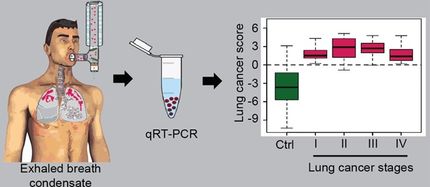Detecting evidence of lung cancer in exhaled breath
Sensing technology could provide a breakthrough in non-invasive lung cancer screening
Exhaled breath contains chemical clues to what’s going on inside the body, including diseases like lung cancer. And devising ways to sense these compounds could help doctors provide early diagnoses — and improve patients’ prospects. In a study in ACS Sensors, researchers report developing ultrasensitive, nanoscale sensors that in small-scale tests distinguished a key change in the chemistry of the breath of people with lung cancer.
People breathe out many gases, such as water vapor and carbon dioxide, as well as other airborne compounds. Researchers have determined that declines in one exhaled chemical — isoprene — can indicate the presence of lung cancer. However, to detect such small shifts, a sensor would need to be highly sensitive, capable of detecting isoprene levels in the parts-per-billion (ppb) range. It would also need to differentiate isoprene from other volatile chemicals and withstand breath’s natural humidity. Previous attempts to engineer gas sensors with characteristics like these have focused on metal oxides, including one particularly promising compound made with indium oxide. A team led by Pingwei Liu and Qingyue Wang set out to refine indium oxide-based sensors to detect isoprene at the level at which it naturally occurs in breath.
The researchers developed a series of indium(III) oxide (In2O3)-based nanoflake sensors. In experiments, they found one type, which they called Pt@InNiOx for the platinum (Pt), indium (In) and nickel (Ni) it contains, performed best. These Pt@InNiOx sensors:
- Detected isoprene levels as low as 2 ppb, a sensitivity that far surpassed earlier sensors.
- Responded to isoprene more than other volatile compounds commonly found in breath.
- Performed consistently during nine simulated uses.
More importantly, the authors' real-time analysis of the nanoflakes' structure and electrochemical properties revealed that Pt nanoclusters uniformly anchored on the nanoflakes catalyzed the activation of isoprene sensing, leading to the ultrasensitive performance.
Finally, to showcase the potential medical use of these sensors, the researchers incorporated the Pt@InNiOx nanoflakes into a portable sensing device. Into this device they introduced breath collected earlier from 13 people, five of whom had lung cancer. The device detected isoprene levels lower than 40 ppb in samples from participants with cancer and more than 60 ppb from cancer-free participants. This sensing technology could provide a breakthrough in non-invasive lung cancer screening and has the potential to improve outcomes and even save lives, the researchers say.
Original publication
Ye Cheng, Raquel Portela, Pingli Wang, Pingwei Liu, Yupeng Mao, Khak Ho Lim, Jieyuan Zheng, Xuan Yang, Gensheng Zhang, Liren Ding, Wen-Jun Wang, Bo-Geng Li, Miguel A. Bañares, Qingyue Wang; "Ultrasensitive In2O3-Based Nanoflakes for Lung Cancer Diagnosis and the Sensing Mechanism Investigated by Operando Spectroscopy"; ACS Sensors, 2024-11-6
Most read news
Original publication
Ye Cheng, Raquel Portela, Pingli Wang, Pingwei Liu, Yupeng Mao, Khak Ho Lim, Jieyuan Zheng, Xuan Yang, Gensheng Zhang, Liren Ding, Wen-Jun Wang, Bo-Geng Li, Miguel A. Bañares, Qingyue Wang; "Ultrasensitive In2O3-Based Nanoflakes for Lung Cancer Diagnosis and the Sensing Mechanism Investigated by Operando Spectroscopy"; ACS Sensors, 2024-11-6
Topics
Organizations

Get the analytics and lab tech industry in your inbox
By submitting this form you agree that LUMITOS AG will send you the newsletter(s) selected above by email. Your data will not be passed on to third parties. Your data will be stored and processed in accordance with our data protection regulations. LUMITOS may contact you by email for the purpose of advertising or market and opinion surveys. You can revoke your consent at any time without giving reasons to LUMITOS AG, Ernst-Augustin-Str. 2, 12489 Berlin, Germany or by e-mail at revoke@lumitos.com with effect for the future. In addition, each email contains a link to unsubscribe from the corresponding newsletter.


























































